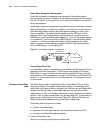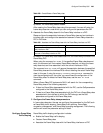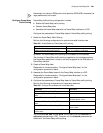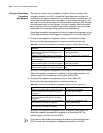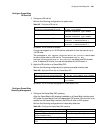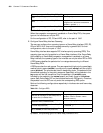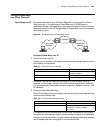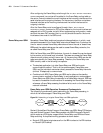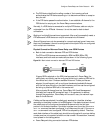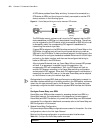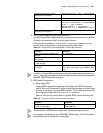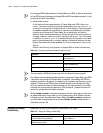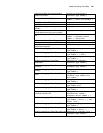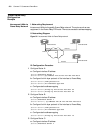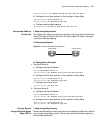
270 CHAPTER 17: CONFIGURING FRAME RELAY
After configuring the Frame Relay route through the fr dlci-switch interface
tunnel
command, two routes will be added to the Frame Relay routing table on
the router. One route takes the tunnel interface as the incoming interface and the
serial interface as the outgoing interface. On the contrary, the other route takes
the serial interface as the incoming interface and the tunnel interface as the
outgoing interface.
After the Frame Relay route is configured through the fr dlci-switch
interface tunnel
command, a PVC will be created on the tunnel interface and
assigned with a DLCI number out-dlci. When implementing configuration, make
sure that the same DLCI number (that is, out-dlci) should be used on the tunnel
interfaces at two ends of the GRE tunnel.
Frame Relay over ISDN Nowadays, Frame Relay technique has gained wide applications, in which, most
devices are accessed to the Frame Relay networks via leased lines. To shorten the
time for users to access Frame Relay networks and lower the cost of leased lines,
ISDNs and the related devices can be used to access Frame Relay networks, the
so-called Frame Relay over ISDN.
With the Frame Relay over ISDN technique, the cost of a leased line can be shared
by the routers, so the overall cost is lowered. The users can access the Frame Relay
networks much quicker and with lower cost. At the same time, ISDN can also be
taken as a standby for Frame Relay accessing. Therefore, the Frame Relay over
ISDN is mainly used in the following two aspects:
■ The simplest application is to take Frame Relay over ISDN as the main
communications method. That is, all the routers support Frame Relay over
ISDN, and the individual routers can directly access the Frame Relay networks
(without TA adapters) to communicate.
■ Combined with BDR, Frame Relay over ISDN can be taken as the standby
communication method for Frame Relay. In such applications, routers support
Frame Relay over ISDN. Being the standby for a Frame Relay network, ISDN can
be used to re-establish the connections for accessing the Frame Relay network,
whenever a Frame Relay accessing line/device fails to work or the Frame Relay
network is blocked.
Frame Relay over ISDN Operation Process and Fundamentals
The following figure shows a typical networking for Frame Relay accessing, in
which all the routers support Frame Relay over ISDN:
Figure 89 Networking of a typical Frame Relay over ISDN application
RouterA, RouterB and RouterC support Frame Relay over ISDN. Being DTE devices,
they and RouterD transmit Frame Relay packets over ISDN B channels. RouterD,
which works as a DCE device, supports both Frame Relay over ISDN and Frame
Relay switching. A simplified working procedure is shown below:
■ RouterA (DTE device) originates a call on the BRI interface to the PRI interface
on RouterD (DCE device).
Frame Relay
Router B
ISDN
Router A
Frame Relay



